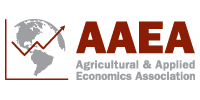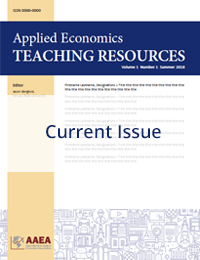Case Study
Automated Milking Systems: A Case Study of a U.S. Midwest Dairy Farm Decision-Making Process
Luis Peña-Lévano(a), Shaheer Burney(b), James Salfer(c), Jennifer Clark(d), Luis Garcia Covarrubias(a), and Cesar Escalant(e)
(a)University of California, Davis, (b)University of Wisconsin-River Falls, (c)University of Minnesota, (d)University of Florida, (e)University of Georgia
JEL Codes: JEL Codes: Q16, Q12, L23, O33, J43
Keywords: Automated milking systems, automation, case study, dairy sector, financial feasibility, robotics
First Published Online: August 13, 2025
View Full Article (PDF) | Request Teaching Notes/Supplemental Materials
Abstract
This case study examines the Schmidt family’s decision at Pioneer Farm in the U.S. Midwest: whether to adopt Automated Milking Systems (AMS) on their dairy farm. AMS are robots that autonomously milk cows, potentially increasing operational efficiency, reducing labor reliance, and improving milk quality. However, installing AMS requires high upfront costs, maintenance expenses, and adjustments to farm management practices, making it a challenging decision for small and mid-sized dairy operations. Using detailed financial data from Pioneer Farm—a fictional farm based on a real farm in the Midwest—the case enables students to analyze the economic feasibility of AMS adoption and explore its impacts on labor dynamics, animal welfare, and long-term sustainability.
The case draws on general industry insights; however, it specifically examines Pioneer Farm’s unique circumstances, providing a realistic and practical framework for classroom discussion. The case illustrates that while AMS can offer substantial long-term economic benefits, initial investment, and maintenance can be major constraints, leading to lackluster adoption rates nationwide. Engaging students in this decision-making process gives them valuable insights into the opportunities and trade-offs associated with technological innovation in the dairy industry. This research also offers valuable lessons for policymakers and educators, contributing to the ongoing discourse on technological innovation in agriculture.
References
Barkema, H.W., M.A.G. von Keyserlingk, J.P. Kastelic, T.J.G. Lam, C. Luby, J.P. Roy, S.J. LeBlanc, G.P. Keefe, and D.F. Kelton. 2015. “Invited Review: Changes in the Dairy Industry Affecting Dairy Cattle Health and Welfare.” Journal of Dairy Science 98(11):7426–7445. https://doi.org/https://doi.org/10.3168/jds.2015-9377.
Brock, C., and B. Barham. 2009. “Farm Structural Change of a Different Kind: Alternative Dairy Farms in Wisconsin—Graziers, Organic and Amish.” Renewable Agriculture and Food Systems 24(1):25–37.
Dairy Farmers of Wisconsin. 2023. Annual Report. Wisconsin Dairy. https://www.wisconsindairy.org/getattachment/Checkoff-at-Work/Annual-Report/23AnnualReport.pdf?lang=en-US.
Driessen, C., and L.F. Heutinck. 2015. “Cows Desiring to Be Milked? Milking Robots and the Co-Evolution of Ethics and Technology on Dutch Dairy Farms.” Agriculture and Human Values 32:3–20.
Heikkilä, A.M., J.I. Nousiainen, and S. Pyörälä. 2012. “Costs of Clinical Mastitis with Special Reference to Premature Culling.” Journal of Dairy Science 95(1):139–150.
Helgren, J.M., and D.J. Reinemann. 2006. “Survey of Milk Quality on U.S. Dairy Farms Utilizing Automatic Milking Systems.” Transactions of the ASABE 49(2):551–556.
Hovinen, M., M. Rasmussen, and S. Pyörälä. 2009. “Udder Health of Cows Changing From Tie Stalls or Free Stalls with Conventional Milking to Free Stalls with Either Conventional or Automatic Milking.” Journal of Dairy Science 92(8):3696–3703.
Jacobs, J., and J. Siegford. 2012. “Invited Review: The Impact of Automatic Milking Systems on Dairy Cow Management, Behavior, Health, and Welfare.” Journal of Dairy Science 95(5):2227–2247.
John, A.J., C.E.F. Clark, M.J. Freeman, K.L. Kerrisk, S.C. Garcia, and I. Halachmi. 2016. “Review: Milking Robot Utilization, A Successful Precision Livestock Farming Evolution.” Animal: An International Journal of Animal Bioscience 10(9):1484–1492.
Liebrand, C. 2022. Dairy Outlook: 2022 Agricultural Outlook Forum. U.S. Department of Agriculture. https://www.usda.gov/sites/default/files/documents/2022AOF-dairy-outlook.pdf.
Luckstead, J., R.M. Nayga, Jr., and H.A. Snell. 2021. “Labor Issues in the Food Supply Chain Amid the COVID‐19 Pandemic.” Applied Economic Perspectives and Policy 43(1):382–400.
Marques, T.C., C.F.A. Lage, D.R. Bruno, E.D. Fausak, M.I. Endres, F.C. Ferreira, and F.S. Lima. 2023. “Geographical Trends for Automatic Milking Systems Research in Non-Pasture-Based Dairy Farms: A Scoping Review.” Journal of Dairy Science 106(11):7725–7736.
Njuki, E. 2022. “Sources, Trends, and Drivers of U.S. Dairy Productivity and Efficiency” (ERR-305). U.S. Department of Agriculture, Economic Research Service.
Peña-Lévano, L., S. Burney, and C. Adams. 2020. “Labor Disruptions Caused by COVID-19 in the U.S. Agriculture and Nonfarm Industries.” Choices 35(3):1–12.
Peña-Lévano, L., S. Burney, and J. Beaudry. 2023. “Automatic Milking Systems: An Exploratory Study of Wisconsin Dairy Farms.” Journal of ASFMRA (2023):74–82.
Rossing, W., and P.H. Hogewerf. 1997. “State of the Art of Automatic Milking Systems.” Computers and Electronics in Agriculture 17(1):1–17.
Rosson, C.P. 2012. “Regional Views on the Role of Immigrant Labor on U.S. and Southern Dairies.” Journal of Agricultural and Applied Economics 44(3):269–277.
Schewe, R.L., and D. Stuart. 2015. “Diversity in Agricultural Technology Adoption: How Are Automatic Milking Systems Used and to What End?” Agriculture and Human Values 32(2):199–213.
Sharipov, D.R., O.A. Yakimov, M.K. Gainullina, A.R. Kashaeva, and I.N. Kamaldinov. 2021, February. “Development of Automatic Milking Systems and Their Classification.” In IOP Conference Series: Earth and Environmental Science (Vol. 659, No. 1). IOP Publishing, p. 012080.
Steeneveld, W., L.W. Tauer, H. Hogeveen, and A.O. Lansink. 2012. “Comparing Technical Efficiency of Farms with an Automatic Milking System and a Conventional Milking System.” Journal of Dairy Science 95(12):7391–7398.
Tranel, L. 2017. “Economics of Robotic Milking Systems. Agricultural Outlook Forum.” Agricultural Outlook Forum, Arlington VA.
Tse, C., H. Barkema, T. DeVries, J. Rushen, E. Vasseur, and E. Pajor. 2018. “Producer Experience with Transitioning to Automatic Milking: Cow Training, Challenges, and Effect on Quality of Life.” Journal of Dairy Science 101(10):9599–9607.
Wisconsin Department of Agriculture, Trade and Consumer Protection (DTCAP). 2024. Wisconsin Agricultural Statistics. Wisconsin Department of Agriculture, Trade and Consumer Protection. https://datcp.wi.gov/Pages/Publications/WIAgStatistics.aspx.
Articles in this issue
Automated Milking Systems: A Case Study of a U.S. Midwest Dairy Farm Decision-Making Process
Luis Peña-Lévano, Shaheer Burney, James Salfer, Jennifer Clark, Luis Garcia Covarrubiasa, et.al
Buyer Market Power in the U.S. Broiler Chicken Industry
Yuliya V. Bolotova
The Implementation of Non-explicit Grading
Timothy Meyer, Lia Nogueira, Fabio Mattos, Simanti Banerjee, and Kathleen Brooks
Production Economics and Efficiency: An Overview
Jean-Paul Chavas
The Case for Transdisciplinary Data Science Education in Agricultural Economics
Jason J. Holderieath, Michael K. Crosby, Lorraine A. Jacques and Pradeep Chowriapp
Exploring the Evolution of Cotton Policy: Linking Politics and Policy in Agricultural Economics Education
Julianne Treme
Commentary on Extension Programming: An Online Platform for Area-Wide Management of Western X-Disease Extension Program
Khashi Ghorbani, Shady S. Atallah and R. Karina Gallardo
Cultivating Farmers, Connections, and Careers: The Utah Urban and Small Farms Conference Experience
Katie Wagner, Kynda Curtis, Ruby Ward, Melanie Stock, and Sheriden Hansen


